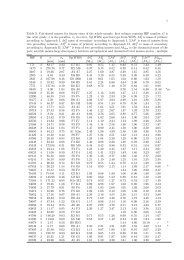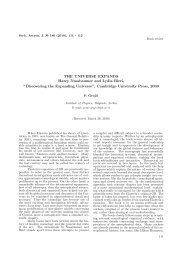dating of mayan calendar using long-periodic astronomical ...
dating of mayan calendar using long-periodic astronomical ...
dating of mayan calendar using long-periodic astronomical ...
You also want an ePaper? Increase the reach of your titles
YUMPU automatically turns print PDFs into web optimized ePapers that Google loves.
DATING OF MAYAN CALENDARTable 1. A set <strong>of</strong> 52 values <strong>of</strong> τ [days], in ascendingorder, authors’ names and dates <strong>of</strong> publication.No. τ Author year1 394483 Bowditch 19102 438906 Willson 19243 449817 Bunge 19404 482699 Smiley 1 19605 482914 Smiley 2 19606 487410 Owen 19757 489138 Makemson 19468 489383 Spinden 1 19309 489384 Spinden 2 192410 489484 Ludendorff 193011 492622 Teeple 192612 497878 Dinsmoor 196513 500210 Smiley 3 196014 507994 Hochleitner 197415 508362 Hochleitner 197416 525698 Hochleitner 197417 550279 Kelley 218 553279 Kelley 1 197619 563334 Martin20 577264 Hochleitner 197221 578585 Hochleitner 197022 583919 Suchtelen 195723 584280 Goodman 190524 584281 Martinez 191825 584283 Thompson 195026 584284 Beyer 193727 584285 Thompson 193528 584286 Lounsbury 197829 584314 Calderon 198230 585789 Cook 197331 588466 Mukerji 193632 588626 Pogo 193733 594250 Schove 1 197634 609417 Hochleitner 197435 615824 Schove 2 197736 622261 B&B (Böhms) 199137 626660 Kaucher 198038 626927 Kreichgauer 192739 660205 Hochleitner 197440 660208 Wells & Fuls 200041 663310 Kelley 2 198342 674265 Hochleitner 197443 674927 Hochleitner 197444 677723 Schulz 195545 679108 Escalona 194046 679183 Vaillant 1 193547 698163 Dittrich 193648 739601 Verbelen 199149 774078 Weitzel 194750 774079 Vollemaere 1 198251 774080 Vollemaere 2 198452 774083 Vaillant 2 1935Additional tests made below will bring newindependent arguments to support the B&B correlation.It is important to note that all phenomenadiscussed here were used neither in deriving the correlation(Böhm and Böhm, 1991, 1996, 1999), norin subsequent tests (Klokočník et al. 2008). This iscompletely new, never and nowhere published. Notefinally that the analyzes presented here are all donefor Palenque (latitude 17 ◦ 29 ′ N, <strong>long</strong>itude 92 ◦ 03 ′ W).The differences for other Mayan localities are negligiblefor our purpose.It is important to note that in the DC theglyphs for the solar eclipses or Venus are shown togetherwith the data (intervals for the relevant phenomenaon the same relevant pages <strong>of</strong> the DC).It provides a confidence that the glyphs and thedata be<strong>long</strong> together. We show the known glyphsin Figs. 1 and 2. But nothing similar was discoveredand confirmed yet for the other planets and theMoon, so one has still to rely only upon possible <strong>astronomical</strong>meaning <strong>of</strong> the time intervals read fromthe DC. When referring to pages in the DC below,D is numbering according to Knorozov (1963), F accordingto Förstemann (1880).D 34a (F 55a) D 35a (F 56a) D 36a (F 57a) D 31b (F 52b)D 33b (F 54b) D 35b (F 56b) D 36b (F 57b) D 37b (F 58b)D 32a (F 53a) D 32b (F 53b)Ah Puch,Ixtab,God <strong>of</strong> Decease Goddess <strong>of</strong> Self-MurderFig. 1. Glyphs for the solar eclipses, according toDresden Codex, tables <strong>of</strong> the eclipses.Fig. 2. Glyphs for Venus, according to Dresden Codex,pp. D 24–D 29 (F 24, 46–50), left and middle,and the glyph for Venus on the altar R in Copán,right.55







